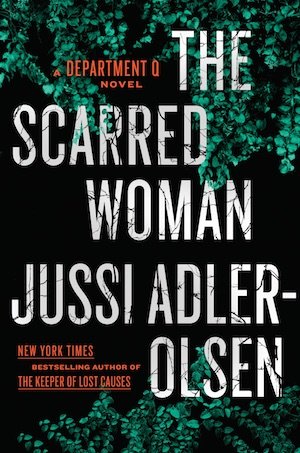
Devotees of this series by Jussi Adler-Olsen will already know that this is what Carl Mørck is like. He is obstinate, interfering and cynical, but he gets results thanks to his persistence and the complementary skills of his team. For a full background, read our full guide to the series here. You’ll find it handy if you read The Scarred Woman standalone, because this is probably the author’s most complex mystery yet. There are plot lines and diversions aplenty – too many, perhaps – but the constant pace of clues, revelations and reversals will keep you turning the pages.
Pretty quickly, the story shifts from Rigmor Zimmerman’s murder to the lifestyle of her granddaughter, Denise. She’s on benefits and living as a prostitute, as well as receiving money every month from her grandmother. But she yearns for something more, and has teamed up with two other attractive young women with similar interests – clothes, hairstyles, make-up, sex and easy money. Together, they’re engineering a robbery.
If Denise is capable of that, could she have killed her grandmother? Oh, and did we mention that she has her grandfather’s World War II Luger, which remains in working order?
The dole-scrounging ways of Denise and her cohorts, Michelle and Jazmine, have not gone unnoticed. A case worker at the social services called Anneli Svendsen has been insulted one too many times by the likes of them. She’s in her mid-50s and a cancer scare has changed her perspective on life. She starts planning a vendetta against young women who work the system instead of getting off their backsides and going to work. She particularly dislikes the ones with hair extensions, tight jeans and colourful fingernails. Denise’s posse are in her sights.
Anneli and the girl gang are on a collision course, and as their stories unfold Adler-Olsen plays with our sympathies. One minute we’re rooting for the girls as they rob a nightclub, the next we’re desperate for payback and a showdown with Anneli. Just as quickly the mood changes to revulsion at the ruthless violence they mete out on each other, and on innocent bystanders.
The detective Carl Mørck, and his assistants Assad and Gordon know nothing of all this. Some hit and runs and a shooting are on their radar, but they’ve got their hands full with two major issues. One is the mental breakdown of their colleague Rose Knudsen. With her multiple personae appearing briefly in previous books, in The Scarred Woman the full extent of her psychological problems is laid bare. It makes for difficult reading. Not only does the author show us the depth of Rose’s mental despair along with its physical effects, but Morck, Assad and Gordon are truly taken down by her plight. The helplessness you may feel trying to support someone with mental illness is made equally clear.
The other issue is their almost clandestine investigation of the two murders. Thanks to some internal politics, this isn’t as clandestine as they’d like because they are shadowed now and again by a TV producer making a series about crime and policing. Another chance for some insight into Carl Mørck’s full spectrum of rudeness.
The author’s plotting is masterful as, like a spider’s web, all the threads lead to a deadly centre. We’ve seen it before with excellent novels in this series such as Mercy and Redemption. Somehow Rose’s plight, Denise’s gang, Anneli’s vendetta, and the murders of Stephanie Gundersen and Rigmor Zimmerman are all linked.
Tonally, the book is a little uneven. There is certainly humour thanks to Carl Morck’s angry outlook, Assad’s unusual grasp of Danish plus his camel-based sayings (he is from the Middle East, after all). But sometimes the writing veers towards the absurd and this seems out of place beside the bigger themes of mental illness, welfare culture, justice and so on. The author has worked to bring greater emotional impact by putting Rose, a main character in the series, under the microscope. Yet the mood is suddenly broken during a crucial scene when, for instance, Morck suddenly notices how nice Assad’s eyelashes look. Most odd. The American translation is the only one available this time and it feels a little different to earlier British ones – softer, less edgy.
It’s a great story, and Adler-Olsen will pull your allegiances this way and that, and have you wanting to know more throughout. There is great momentum within the plot and in a short space of time the action moves all around the city. There are police procedural elements in the book, but the series has become increasingly character-driven and that’s reflected in this novel. Another fine read for your Scandinavian crime fiction bookshelf.
For more Danish crime fiction, try The Susan Effect by Peter Hoeg, or What my Body Remembers by Agnete Friis. Read our interview with Jussi Adler-Olsen here.
Quercus/Dutton
Print/Kindle/iBook
£9.49/$18.30
CFL Rating: 4 Stars